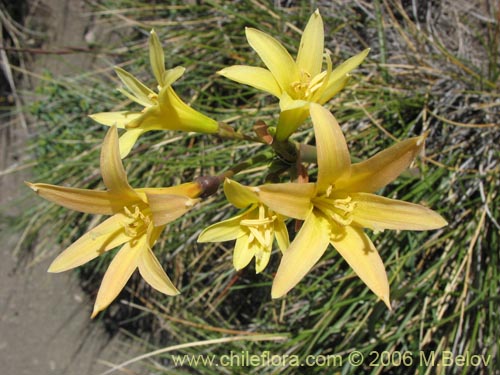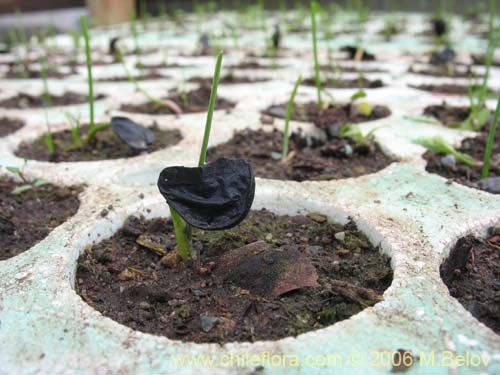Cierre esta ventana
Entrar a la Tienda de Semillas

|
||||||||||||||||||
This is another Rhodophiala of the Central Andes of Chile - it has big flowers, somewhat smaller than of the other Rhodophialas, of almost pure yellow color. Although it is considered rare, in the few places where it grows, it can be found in largequantities. This is a perennial bulbous plant of about 20 - 30 cm. The leaves are generally absent during the flourishing. The leaves are linear and 10 - 20 cm long and about 5 - 8 mm wide. The plant has yellow flowers with six yellow stamens and one yellowishpistil which is quite longer than the stamens. The flowers come in groups of 3 - 6. The seeds come in a three-parted greenish-brown capsule which contains about 20 - 40 shiny black flat round seeds of 1 cm of diameter stacked up one on the other like pages of a book. The flowers appear in November - January, and the seeds are ripe in February-March. This plant may hybridize with the Rhodophiala rhodolirion, because in places where they grow together the yellow color may take a pinkish, reddishor orange hue. This plant gows at high elevations in Central-southern Chile, in Talca at about 1600 - 2100 m., close to the tree line, prefers sunny spots, generally on sandy or rocky ground with good drainage; it grows preferably on soils with low organic content. It needs a lot of water during its vegetative growth (in early spring), but during the flowering it can withstand dry spells of up to two months (the bulbs store nutrients and water necessary for flowering). It can be easily propaged by seeds or by division of bulbs. The seeds must be immersed in water for a day o two and then planted at about 18?C. The stratification at cold temperatures seems to be not necessary for this variety. Do not expect flowers for at least two seasons, because the bulb needs time to develop. Ornamental. There are oral reports (not confirmed) of local people indicating that its bulb may be edible. |
||||||||||||||||||


